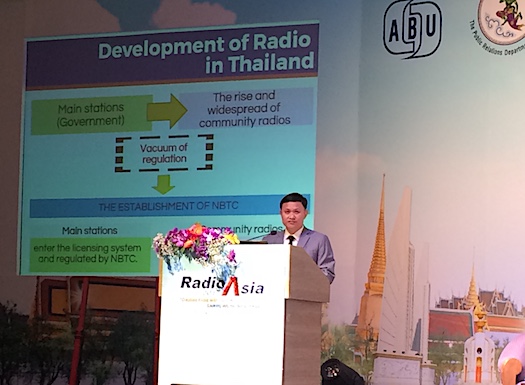Speaking at the Radio Asia conference in Thailand, the chairman of the country's regulator NBTC, Colonel Sukonrat outlined some the problems currently being experienced by the Thai radio industry.
During the coup, many stations were shut down, but now that they are back on air some other problems have materialised.
“We have some issues,” said Sukonrat:
“There are too many stations, especially the trial stations; there is frequency interference; and there are delays in technological development.”
Outlining the solutions the regulator will pursue to solve these problems, he said: “We will reduce the number of FM stations, standardise radio devices and transmission to lower interference, and regulate illegal and inappropriate content.”
In the longer term the country also plans to move to digital broadcasting.
“Radio is a crucial means of communication in Thailand,” he said, telling delegates there are 193 AM stations on air, 313 FM stations and 5418 FM trial stations.
The trial stations are community stations that were recently licenced temporarily, to recognise the fact that they were on air but were previously unlicenced because there was no regulator. NBTC is now reviewing those stations with a view to closing or rationalising some of them over time, to clear the spectrum of interference.
There are 10 million radios in Thai households, but this number has fallen in the past ten years.
Radio ad spending has also declined over the past decade. It was ฿ 6616 (Thai Baht) in 2013 but is now ฿ 5263 last year.
In other sessions, Fayyaz Sheheryar from All India Radio spoke about how India needs different modes of broadcasting to serve all the people of the nation.
“Does radio have a future? People asked this question when television came, yet radio still survives… Radio has staged a comeback.
“But the questions remains in the world’s largest middle class society – where is radio going? In a world shifting gears fast and furious, where is radio headed for?”
As well as technological challenges to radio, there are other societal changes that need to be considered according to Sheheryar. They include: conflict between people’s aspirations and the establishment; social disharmony and conflicts; the rise of fundamentalism and pressure from the corporate sector and revenue pressure.
“Radio is the only counterpoint for people lost in the problems of the modern society,” he said. “It is also an instant medium for help in peace, in turmoil and in disaster. Radio is more than a medium, it is a companion.”
Joan Warner from Commercial Radio Australia discussed the success of radio in Australia, focusing on innovative radio content creation.
“Radio businesses need to continue moving forward while keeping their deep connections with their audiences,” she said, but warned that broadcasting needs to remain free to air and “not be controlled by gatekeepers such as internet providers.”
Tackling the PR benefits gained by new media, Warner said: “Shiny new media entrants gain attention because they are new, but existing media need to remind the audience that they are here too… promote, promote, promote!”
“Radio’s future is multi-platform but the core business model for the foreseeable future is in free to air broadcasting.”
She urged radio broadcasters to invest in good talent, create a “sticky social media presence” and reinforce to stakeholders that radio delivers a “brand safe environment for advertisers.”
“Radio should not take a backwards step, produce radio with passion and confidence,” said Warner.
Follow the conference over the next few days here on AsiaRadioToday, and download the program here.

